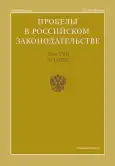Анализ опасностей, связанных с появлением роботов, передвигающихся в пешеходных зонах
- Авторы: Тарасов А.Ю.1, Тарасова И.А.1
-
Учреждения:
- Московский областной филиал Московского университета МВД России имени В.Я. Кикотя
- Выпуск: Том 17, № 1 (2024)
- Страницы: 20-26
- Раздел: Теоретико-исторические правовые науки
- URL: https://journals.rcsi.science/2072-3164/article/view/254124
- EDN: https://elibrary.ru/OLKDWN
- ID: 254124
Цитировать
Аннотация
Целью статьи является изучение опасностей, связанных с появлением роботов, передвигающихся в пешеходных зонах. В качестве объекта исследования выступают общественные отношения в сфере взаимодействия пешеходов и роботов. При этом предметом исследования являются технологии, лежащие в основе полуавтономных и полностью автономных роботов влияющие на безопасность людей при контакте с ними. В рамках методологии исследования с использованием сравнительно-правового метода осуществлен анализ основных этапов развития и становления технологий современных роботов с большой степенью автономности.
Лозунг «роботы захватят нашу среду» становится реальностью. Дроны и наземные роботы-доставщики используются в коммерческих целях, а полуавтономные системы вождения являются стандартными аксессуарами для традиционных автомобилей. Однако в то время как наши глаза были прикованы к опасностям и авариям, связанным с падением дронов и авариями автономных автомобилей, гораздо меньше внимания было обращено на опасности, связанные с неизбежным появлением роботов, которые делят пространство с пешеходами и смешиваются с человеческими потоками. Эти роботы варьируются от полуавтономных или автономных мобильных платформ, предназначенных для предоставления нескольких видов услуг, таких как помощник, патрулирование, гид, доставка, транспортировка людей и т. д.
Особое внимание мы уделяем опасностям, исходящим от роботов, движущихся в пешеходных потоках. В таких ситуациях контакт не только неизбежен, но и может быть не безопасен.
Ключевые слова
Полный текст
Открыть статью на сайте журналаОб авторах
Александр Юрьевич Тарасов
Московский областной филиал Московского университета МВД России имени В.Я. Кикотя
Автор, ответственный за переписку.
Email: 7137355@gmail.com
кандидат юридических наук, доцент, начальник кафедры организации деятельности подразделений по обеспечению безопасности дорожного движения
Россия, пос. Старотеряево, Московская обл.Ирина Анатольевна Тарасова
Московский областной филиал Московского университета МВД России имени В.Я. Кикотя
Email: tarasovairina2@rambler.ru
кандидат юридических наук, доцент, доцент кафедры государственных и гражданско-правовых дисциплин
Россия, пос. Старотеряево, Московская обл.Список литературы
- Jiang B. C, Gainer C. A. Причинно-следственный анализ несчастных случаев с роботами Оккупация Акк 9 (1): doi.org /10.1016/0376-6349(87)90023-X.
- Станчу С. К., Эби Д. В., Молнар Л. Дж., Заньер Н., Костынюк Л. П. (2018) Пешеходы / велосипедисты и автономные транспортные средства: как они будут общаться? Transp Res, 2018: doi.org /10.1177/03611 98118777091.
- Pandey A. K, Gelin R. Pepper: первая машина в своем роде. Массовый общительный робот-гуманоид. IEEE Robot Autom Mag, 2018.
- Иванов С. Х., Вебстер С., Березина К. Внедрение роботов и автоматизация услуг туристическими и гостиничными компаниями. Rev Turismo Desenvol, 2017.
- Мансфельд Н., Хамад М., Беккер М., Марин А.Г., Хаддадин С. (2018) Карта безопасности: унифицированное представление данных о воздействии биомеханики и мгновенных динамических свойств робота. IEEE Robot Autom Lett, 2018.
- Fujikawa T, Kubota M, Yamada Y, Ikeda H (2013) Оценка детского травматизма при столкновении на основе данных об автомобильных авариях для оценки риска мобильных роботов. Международная конференция IEEE по интеллектуальным роботам и системам, 2013.
- Kim H. Y, Park J. H, Yun S, Moon S, Gwak K.W. Предварительные результаты экспериментов по сжатию грудной клетки при неограниченном столкновении мобильного робота и человека. Международная конференция по управлению, автоматизации и системам, 2017.
- Dondrup C., Hanheide M. Качественные ограничения для ориентированной на человека навигации роботов с использованием Velocity Costmaps. 25-й международный симпозиум IEEE по интерактивному общению роботов и людей. 2016: doi.org /10.1109/ ROMAN.2016.7745177.
- Окал Б., Аррас К. О. Изучение социально нормативного поведения роботов при навигации с помощью байесовского обучения с обратным подкреплением. Международная конференция IEEE по робототехнике и автоматизации, 2016: doi.org/10.
- Райнер К., Рунке М., Стедер Б., Стахнисс К., Бургард В. Автономная навигация роботов в густонаселенных пешеходных зонах. Полевой робот 33 (1), 2014: doi.org/10.
- Хаддадин С., Де Лука А., Альбу-Шефер А. Столкновения роботов: обзор обнаружения, изоляции и идентификации. IEEE Trans Rob 33(6), 2017: doi.org/10.1109/ TRO.2017.2723903.
- Ласота П. А., Фонг Т., Шах Дж .А. Обзор методов безопасного взаимодействия человека и робота. Found Trends Rob, 2014: doi.org/10.1561/2300000052.
- Розенстраух М. Дж., Крюгер Дж. Безопасное взаимодействие человека и робота – введение и эксперимент с использованием ISO/TS 15066. 3-я международная конференция по управлению, автоматизации и робототехнике, 2017.
- Биллард А. О механических, когнитивных и социальных аспектах подчинения человека и их роботизированных аналогов. Rob Auton Syst 88, 2017.
- «Отчет с рекомендациями Комиссии по гражданско-правовым нормам в области робототехники», опубликованный 27.01.2017. URL: http:// www.europarl.europa.eu/sides/getDoc.do.
Дополнительные файлы








